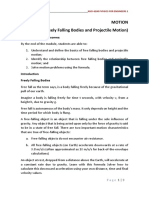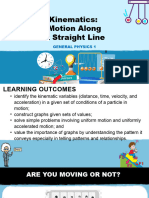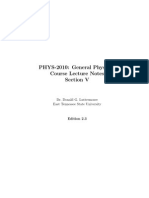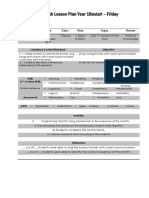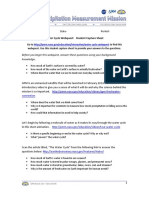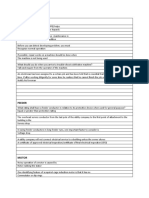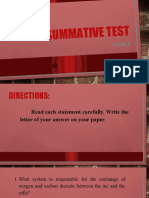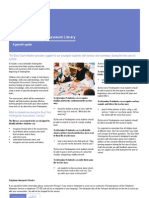Ch07 PPT Notes
Ch07 PPT Notes
Uploaded by
Beverly PamanCopyright:
Available Formats
Ch07 PPT Notes
Ch07 PPT Notes
Uploaded by
Beverly PamanOriginal Description:
Original Title
Copyright
Available Formats
Share this document
Did you find this document useful?
Is this content inappropriate?
Copyright:
Available Formats
Ch07 PPT Notes
Ch07 PPT Notes
Uploaded by
Beverly PamanCopyright:
Available Formats
7 Newtons Third Law of MotionAction and Reaction
For every force, there
is an equal and
opposite force.
7 Newtons Third Law of MotionAction and Reaction
7.1 Forces and Interactions
A force is always part of an
interaction between 2 objects that
involves another force.
7 Newtons Third Law of MotionAction and Reaction
7.1 Forces and Interactions
When you push on the wall, the wall pushes on you.
7 Newtons Third Law of MotionAction and Reaction
7.1 Forces and Interactions
The interaction that drives the nail is the same as the
one that halts the hammer.
There are a pair of
forces, one acting on
the nail and the other
acting on the hammer.
7 Newtons Third Law of MotionAction and Reaction
7.1 Forces and Interactions
think!
Does a stick of dynamite contain force? Explain.
7 Newtons Third Law of MotionAction and Reaction
7.1 Forces and Interactions
think!
Does a stick of dynamite contain force? Explain.
Answer: No. Force is not something an object has, like
mass. Force is an interaction between one object and
another. An object cannot possess force as a thing in itself.
Later we will see that something like a stick of dynamite
possesses energy.
7 Newtons Third Law of MotionAction and Reaction
7.2 Newtons Third Law
Newtons third law states that
whenever one object exerts a force on
a second object, the second object
exerts an equal and oppositely
directed force on the first object.
7 Newtons Third Law of MotionAction and Reaction
7.2 Newtons Third Law
Newtons third law describes the relationship between two
forces in an interaction between 2 objects.
One force is called the action force.
The other force is called the reaction force.
One force acts on each object
Neither force exists without the other.
They are equal in strength and opposite in direction.
They occur at the same time (simultaneously).
They are the same type of force (gravity, electric,
etc)
7 Newtons Third Law of MotionAction and Reaction
7.3 Identifying Action and Reaction
To identify a pair of action-reaction
forces, first identify the interacting
objects A and B, and if the action is A
on B, the reaction is B on A.
7 Newtons Third Law of MotionAction and Reaction
7.2 Newtons Third Law
Examples of 3rd Law Pairs:
You push against the floor, and the floor
simultaneously pushes against you.
The tires of a car push against the road, and the road
simultaneously pushes back on the tires.
When swimming, you push the water backward, and
the water pushes you forward.
7 Newtons Third Law of MotionAction and Reaction
7.3 Identifying Action and Reaction
There is a simple recipe for treating action and reaction
forces:
First identify the interaction. Lets say one object, A,
interacts with another object, B.
The action and reaction forces are stated in the form:
Action: Object A exerts a force on object B.
Reaction: Object B exerts a force on object A.
7 Newtons Third Law of MotionAction and Reaction
7.3 Identifying Action and Reaction
Sometimes the identity of the pair of action and reaction
forces in an interaction is not immediately obvious.
For example, what are the action and reaction forces
in the case of a falling boulder?
If we call the action Earth exerting a force on the
boulder, then the reaction is the boulder
simultaneously exerting a force on Earth.
7 Newtons Third Law of MotionAction and Reaction
7.3 Identifying Action and Reaction
When action is A exerts force on B, the reaction is simply B
exerts force on A.
7 Newtons Third Law of MotionAction and Reaction
7.3 Identifying Action and Reaction
When action is A exerts force on B, the reaction is simply B
exerts force on A.
7 Newtons Third Law of MotionAction and Reaction
7.3 Identifying Action and Reaction
think!
We know that Earth pulls on the moon. Does the moon also
pull on Earth? If so, which pull is stronger?
7 Newtons Third Law of MotionAction and Reaction
7.3 Identifying Action and Reaction
think!
We know that Earth pulls on the moon. Does the moon also
pull on Earth? If so, which pull is stronger?
Answer: Asking which pull is stronger is like asking which
distance is greaterbetween New York and San Francisco,
or between San Francisco and New York. The distances
either way are the same. It is the same with force pairs. Both
Earth and moon pull on each other with equal and opposite
forces.
7 Newtons Third Law of MotionAction and Reaction
7.4 Action and Reaction on Different Masses
A given force exerted on a small mass
produces a greater acceleration than
the same force exerted on a large mass.
7 Newtons Third Law of MotionAction and Reaction
7.4 Action and Reaction on Different Masses
Consider the interaction between a
boulder and the Earth
Earth is pulled up by the boulder
with just as much force as the
boulder is pulled down by Earth.
(equal size, but oppositely directed)
Although the forces are the same,
the masses are very different.
Thus, their accelerations are very
different.
7 Newtons Third Law of MotionAction and Reaction
7.4 Action and Reaction on Different Masses
Boulder and Earth continued
Acceleration is not only proportional to the net force, but it is
also inversely proportional to the mass.
Because Earth has a huge mass, we dont sense its
infinitesimally small acceleration.
7 Newtons Third Law of MotionAction and Reaction
7.4 Action and Reaction on Different Masses
Force and Mass
When a cannon is fired, there is an interaction between the
cannon and the cannonball.
The force the cannon exerts on the cannonball is exactly
equal and opposite to the force the cannonball exerts on
the cannon.
You might expect the cannon to kick more than it does.
The cannonball moves so fast compared with the
cannon.
According to Newtons second law, we must also
consider the masses.
7 Newtons Third Law of MotionAction and Reaction
7.4 Action and Reaction on Different Masses
Consider the firing of a cannon
The cannonball undergoes more acceleration than
the cannon because its mass is much smaller.
7 Newtons Third Law of MotionAction and Reaction
7.4 Action and Reaction on Different Masses
F represents both the action and reaction forces; m (large),
the mass of the cannon; and m (small), the mass of the
cannonball.
Do you see why the change in the velocity of the cannonball is
greater compared with the change in velocity of the cannon?
7 Newtons Third Law of MotionAction and Reaction
7.4 Action and Reaction on Different Masses
We can extend the basic idea of a cannon recoiling from the
cannonball it launches to understand rocket propulsion.
Yes, this is rocket science!!!
7 Newtons Third Law of MotionAction and Reaction
7.4 Action and Reaction on Different Masses
The balloon recoils from the escaping
air and climbs upward.
7 Newtons Third Law of MotionAction and Reaction
7.4 Action and Reaction on Different Masses
If a balloon is released and allowed to move, it accelerates
as the air comes out.
A rocket accelerates in much the same wayit continually
recoils from the exhaust gases ejected from its engine.
Each molecule of exhaust gas acts like a tiny molecular
cannonball shot downward from the rocket.
7 Newtons Third Law of MotionAction and Reaction
7.4 Action and Reaction on Different Masses
A common misconception is that a rocket is propelled by the
impact of exhaust gases against the atmosphere.
Both the rocket and recoiling cannon accelerate because of
the reaction forces created by the cannonballs they fire
air or no air.
In fact, rockets work better above the atmosphere where
there is no air resistance.
7 Newtons Third Law of MotionAction and Reaction
7.4 Action and Reaction on Different Masses
The rocket recoils from the
molecular cannonballs it
fires and climbs upward.
7 Newtons Third Law of MotionAction and Reaction
7.4 Action and Reaction on Different Masses
Lift
Using Newtons third law, we can understand how a helicopter
gets its lifting force.
The whirling blades force air particles downward
(action).
The air forces the blades upward (reaction).
This upward reaction force is called lift.
When lift equals the weight of the craft, the helicopter
hovers in midair. When lift is greater, the helicopter
accelerates upward.
7 Newtons Third Law of MotionAction and Reaction
7.4 Action and Reaction on Different Masses
Birds and airplanes also fly because of action and reaction
forces.
When a bird is soaring, the shape of its wings deflects air
downward. The air in turn pushes the bird upward.
The slightly tilted wings of an airplane also deflect oncoming
air downward and produce lift.
7 Newtons Third Law of MotionAction and Reaction
7.5 Defining Systems
Action and reaction forces do not
cancel each other when either of the
forces is external to the system being
considered.
7 Newtons Third Law of MotionAction and Reaction
7.5 Defining Systems
Since action and reaction forces are equal and opposite,
why dont they cancel to zero?
To answer this question, we must consider the system
involved.
7 Newtons Third Law of MotionAction and Reaction
7.5 Defining Systems
A force acts on the orange, and the orange accelerates to
the right.
The dashed line surrounding the orange encloses and
defines the system.
7 Newtons Third Law of MotionAction and Reaction
7.5 Defining Systems
The vector that pokes outside the dashed line represents an
external force on the system.
The system (that is, the orange) accelerates in accord with
Newtons second law.
7 Newtons Third Law of MotionAction and Reaction
7.5 Defining Systems
The force on the orange, provided by the apple, is not
cancelled by the reaction force on the apple. The orange
still accelerates.
7 Newtons Third Law of MotionAction and Reaction
7.5 Defining Systems
The force is provided by an apple, which doesnt change
our analysis. The apple is outside the system.
The fact that the orange simultaneously exerts a force on
the apple, which is external to the system, may affect the
apple (another system), but not the orange.
You cant cancel a force on the orange with a force on the
apple. So in this case the action and reaction forces dont
cancel.
7 Newtons Third Law of MotionAction and Reaction
7.5 Defining Systems
a. Action and
reaction forces
cancel.
7 Newtons Third Law of MotionAction and Reaction
7.5 Defining Systems
a. Action and
reaction forces
cancel.
b. When the floor
pushes on the
apple (reaction to
the apples push
on the floor), the
orange-apple
system
accelerates.
7 Newtons Third Law of MotionAction and Reaction
7.5 Defining Systems
When the force pair is internal to the orange-apple system,
the forces do cancel each other. They play no role in
accelerating the system.
A force external to the system is needed for acceleration.
When the apple pushes against the floor, the floor
simultaneously pushes on the applean external
force on the system.
The system accelerates to the right.
7 Newtons Third Law of MotionAction and Reaction
7.5 Defining Systems
Inside a baseball, trillions of interatomic forces hold the ball
together but play no role in accelerating the ball. They are
part of action-reaction pairs within the ball, but they combine
to zero.
If the action-reaction forces are internal to the system, then
they cancel and the system does not accelerate.
A force external to the ball, such as a swinging bat provides,
is needed to accelerate the ball.
7 Newtons Third Law of MotionAction and Reaction
7.5 Defining Systems
A football is kicked.
a. A acts on B and
B accelerates.
7 Newtons Third Law of MotionAction and Reaction
7.5 Defining Systems
A football is kicked.
a. A acts on B and
B accelerates.
b. Both A and C
act on B. They
can cancel
each other so B
does not
accelerate.
7 Newtons Third Law of MotionAction and Reaction
7.5 Defining Systems
When there is one interaction between the foot and the
football, the ball accelerates.
If two kicks on the ball are simultaneous, equal, and
opposite, then the net force on the ball is zero.
The opposing forces act on the same object, not on different
objects, so they do not make up an action-reaction pair.
7 Newtons Third Law of MotionAction and Reaction
7.5 Defining Systems
think!
Suppose a friend who hears about Newtons third law says
that you cant move a football by kicking it because the
reaction force by the kicked ball would be equal and
opposite to your kicking force. The net force would be zero,
so no matter how hard you kick, the ball wont move! What
do you say to your friend?
7 Newtons Third Law of MotionAction and Reaction
7.5 Defining Systems
think!
Suppose a friend who hears about Newtons third law says
that you cant move a football by kicking it because the
reaction force by the kicked ball would be equal and
opposite to your kicking force. The net force would be zero,
so no matter how hard you kick, the ball wont move! What
do you say to your friend?
Answer: If you kick a football, it will accelerate. No other
force has been applied to the ball. Tell your friend that you
cant cancel a force on the ball with a force on your foot.
7 Newtons Third Law of MotionAction and Reaction
7.5 Defining Systems
Why dont action-reaction forces
cancel each other?
7 Newtons Third Law of MotionAction and Reaction
7.6 The Horse-Cart Problem
If the horse in the horse-cart system
pushes the ground with a greater force
than it pulls on the cart, there is a net
force on the horse, and the horse-cart
system accelerates.
7 Newtons Third Law of MotionAction and Reaction
7.6 The Horse-Cart Problem
All the pairs of forces that act on the horse and cart are
shown. The acceleration of the horse-cart system is due to
the net force F f.
7 Newtons Third Law of MotionAction and Reaction
7.6 The Horse-Cart Problem
Will the horses pull on the cart be canceled by the opposite
and equal pull by the cart on the horse, thus making
acceleration impossible?
From the farmers point of view, the only concern is with the
force that is exerted on the cart system.
The net force on the cart, divided by the mass of the
cart, is the acceleration.
The farmer doesnt care about the reaction on the
horse.
7 Newtons Third Law of MotionAction and Reaction
7.6 The Horse-Cart Problem
Now look at the horse system.
The opposite reaction force by the cart on the horse
restrains the horse.
Without this force, the horse could freely gallop to the
market.
The horse moves forward by interacting with the
ground.
When the horse pushes backward on the ground, the
ground simultaneously pushes forward on the horse.
7 Newtons Third Law of MotionAction and Reaction
7.6 The Horse-Cart Problem
Look at the horse-cart system as a whole.
The pull of the horse on the cart and the reaction of
the cart on the horse are internal forces within the
system.
They contribute nothing to the acceleration of the
horse-cart system. They cancel and can be neglected.
7 Newtons Third Law of MotionAction and Reaction
7.6 The Horse-Cart Problem
To move across the ground, there must be an interaction
between the horse-cart system and the ground.
It is the outside reaction by the ground that pushes the
system.
7 Newtons Third Law of MotionAction and Reaction
7.6 The Horse-Cart Problem
7 Newtons Third Law of MotionAction and Reaction
7.6 The Horse-Cart Problem
think!
What is the net force that acts on the cart? On the horse?
On the ground?
7 Newtons Third Law of MotionAction and Reaction
7.6 The Horse-Cart Problem
think!
What is the net force that acts on the cart? On the horse?
On the ground?
Answer: The net force on the cart is Pf; on the horse, FP;
on the ground Ff.
7 Newtons Third Law of MotionAction and Reaction
7.6 The Horse-Cart Problem
How does a horse-cart system accelerate?
7 Newtons Third Law of MotionAction and Reaction
7.7 Action Equals Reaction
For every interaction between things,
there is always a pair of oppositely
directed forces that are equal in
strength.
7 Newtons Third Law of MotionAction and Reaction
7.7 Action Equals Reaction
If you hit the wall, it will hit you equally hard.
7 Newtons Third Law of MotionAction and Reaction
7.7 Action Equals Reaction
If a sheet of paper is held in midair, the heavyweight
champion of the world could not strike the paper with a
force of 200 N (45 pounds).
The paper is not capable of exerting a reaction force of
200 N, and you cannot have an action force without a
reaction force.
If the paper is against the wall, then the wall will easily
assist the paper in providing 200 N of reaction force, and
more if needed!
7 Newtons Third Law of MotionAction and Reaction
7.7 Action Equals Reaction
If you push hard on the world, for example, the world
pushes hard on you.
If you touch the world gently, the world will touch you
gently in return.
7 Newtons Third Law of MotionAction and Reaction
7.7 Action Equals Reaction
You cannot touch without being touchedNewtons third law.
7 Newtons Third Law of MotionAction and Reaction
7.7 Action Equals Reaction
What must occur in every interaction
between things?
7 Newtons Third Law of MotionAction and Reaction
Assessment Questions
1.
A force interaction requires at least a(n)
a. single force.
b. pair of forces.
c. action force.
d. reaction force.
7 Newtons Third Law of MotionAction and Reaction
Assessment Questions
1.
A force interaction requires at least a(n)
a. single force.
b. pair of forces.
c. action force.
d. reaction force.
Answer: B
7 Newtons Third Law of MotionAction and Reaction
Assessment Questions
2.
Whenever one object exerts a force on a second object, the second
object exerts a force on the first that is
a. opposite in direction and equal in magnitude at the same time.
b. in the same direction and equal in magnitude a moment later.
c. opposite in direction and greater in magnitude at the same time.
d. in the same direction and weaker in magnitude a moment later.
7 Newtons Third Law of MotionAction and Reaction
Assessment Questions
2.
Whenever one object exerts a force on a second object, the second
object exerts a force on the first that is
a. opposite in direction and equal in magnitude at the same time.
b. in the same direction and equal in magnitude a moment later.
c. opposite in direction and greater in magnitude at the same time.
d. in the same direction and weaker in magnitude a moment later.
Answer: A
7 Newtons Third Law of MotionAction and Reaction
Assessment Questions
3.
The force that directly propels a motor scooter along a highway is that
provided by the
a. engine.
b. fuel.
c. tires.
d. road.
7 Newtons Third Law of MotionAction and Reaction
Assessment Questions
3.
The force that directly propels a motor scooter along a highway is that
provided by the
a. engine.
b. fuel.
c. tires.
d. road.
Answer: D
7 Newtons Third Law of MotionAction and Reaction
Assessment Questions
4.
When you jump vertically upward, strictly speaking, you cause Earth
to
a. move downward.
b. also move upward with you.
c. remain stationary.
d. move sideways a bit.
7 Newtons Third Law of MotionAction and Reaction
Assessment Questions
4.
When you jump vertically upward, strictly speaking, you cause Earth
to
a. move downward.
b. also move upward with you.
c. remain stationary.
d. move sideways a bit.
Answer: A
7 Newtons Third Law of MotionAction and Reaction
Assessment Questions
5.
A system undergoes acceleration only when acted on by a(n)
a. net force.
b. pair of forces.
c. action and reaction forces.
d. internal interactions.
7 Newtons Third Law of MotionAction and Reaction
Assessment Questions
5.
A system undergoes acceleration only when acted on by a(n)
a. net force.
b. pair of forces.
c. action and reaction forces.
d. internal interactions.
Answer: A
7 Newtons Third Law of MotionAction and Reaction
Assessment Questions
6.
If a net force acts on a horse while it is pulling a wagon, the
horse
a. accelerates.
b. is restrained.
c. is pulled backward by an equal and opposite net force.
d. cannot move.
7 Newtons Third Law of MotionAction and Reaction
Assessment Questions
6.
If a net force acts on a horse while it is pulling a wagon, the
horse
a. accelerates.
b. is restrained.
c. is pulled backward by an equal and opposite net force.
d. cannot move.
Answer: A
7 Newtons Third Law of MotionAction and Reaction
Assessment Questions
7.
At a pizza shop, the cook throws the pizza dough in the air. The
amount of force the cook exerts on the dough depends on the
a. mass of the dough.
b. strength of the cook.
c. weight of the dough.
d. height of the cook.
7 Newtons Third Law of MotionAction and Reaction
Assessment Questions
7.
At a pizza shop, the cook throws the pizza dough in the air. The
amount of force the cook exerts on the dough depends on the
a. mass of the dough.
b. strength of the cook.
c. weight of the dough.
d. height of the cook.
Answer: A
You might also like
- NFC 33-020-2013Document20 pagesNFC 33-020-2013Jonutz100% (4)
- SevenRooms VMS (Dining)Document20 pagesSevenRooms VMS (Dining)Charlotte's WangNo ratings yet
- Lab Report 3 - Energy and MotionDocument6 pagesLab Report 3 - Energy and MotionDawood SulemanNo ratings yet
- Fitrep Brief May 05Document66 pagesFitrep Brief May 05Beverly PamanNo ratings yet
- Statistics For Dummies, 2nd EditionDocument3 pagesStatistics For Dummies, 2nd EditionEmilynBernardoNo ratings yet
- Lesson 1 - Introduction To Physics and MeasurementDocument12 pagesLesson 1 - Introduction To Physics and MeasurementHanah ArzNo ratings yet
- Experiment 1: Measurements and Error Analysis Laboratory ReportDocument5 pagesExperiment 1: Measurements and Error Analysis Laboratory ReportCharisse PondocNo ratings yet
- DiscipleCourse NotesDocument8 pagesDiscipleCourse NotesNashvinNo ratings yet
- Newtons Third Law of MotionDocument24 pagesNewtons Third Law of MotionMARY GRACE FACULARINNo ratings yet
- 0708 Laws of MotionDocument32 pages0708 Laws of MotionKanagaraj ChelladuraiNo ratings yet
- Relative Motion 1Document14 pagesRelative Motion 1Kofoworola MikailNo ratings yet
- Z-Scores and Percentiles Practice Problems 2Document4 pagesZ-Scores and Percentiles Practice Problems 2Jaster Monloise Baña SanicoNo ratings yet
- Relative MotionDocument23 pagesRelative MotionkvinzonNo ratings yet
- MomentumDocument40 pagesMomentumAdri versouisseNo ratings yet
- Living ThingsDocument10 pagesLiving ThingsJosefa Jerez0% (1)
- PhysicsDocument21 pagesPhysicsMira NuquiNo ratings yet
- Capstone PowerpointDocument36 pagesCapstone PowerpointJovel AbellarNo ratings yet
- Motion (Freely Falling Bodies and Projectile Motion) : Course Learning OutcomesDocument9 pagesMotion (Freely Falling Bodies and Projectile Motion) : Course Learning OutcomesYoo JungNo ratings yet
- ExtinctionDocument36 pagesExtinctionabhishek 1100% (9)
- TIMSS Assessment Framework Outline (Group 3)Document7 pagesTIMSS Assessment Framework Outline (Group 3)heystobitNo ratings yet
- Lesson 11.4: Scatter Plots: Standards: SDP 1.0 and 1.2 Objective: Determine The Correlation of A Scatter PlotDocument14 pagesLesson 11.4: Scatter Plots: Standards: SDP 1.0 and 1.2 Objective: Determine The Correlation of A Scatter PlotRamanand YadavNo ratings yet
- Ch3-Forces DynamicsDocument42 pagesCh3-Forces DynamicsJimmy LauNo ratings yet
- 6 L2 Literature ReviewDocument26 pages6 L2 Literature ReviewGadisa FitalaNo ratings yet
- Problems With Solutions: Addition of VectorsDocument6 pagesProblems With Solutions: Addition of VectorsSanNo ratings yet
- Chapter 1 (Week 1)Document87 pagesChapter 1 (Week 1)Amirah AdlinaNo ratings yet
- Complete - Lesson 2 CorrDocument26 pagesComplete - Lesson 2 CorrMARION JUMAO-AS GORDONo ratings yet
- Performance of Philippine High Schools With Special ScienceDocument18 pagesPerformance of Philippine High Schools With Special ScienceRachel Ann EstanislaoNo ratings yet
- General Guidelines For Undergraduate Research Capstone Project Revised 2021Document6 pagesGeneral Guidelines For Undergraduate Research Capstone Project Revised 2021Althea Marie AvilaNo ratings yet
- Center of MassDocument3 pagesCenter of MassMartha Glorie Manalo WallisNo ratings yet
- Rubrics in Group ActivityDocument1 pageRubrics in Group ActivityRobert Kier Tanquerido TomaroNo ratings yet
- MCQDocument29 pagesMCQRadsreadsNo ratings yet
- 1 - Lesson 2 Vectors, Displacement & DistanceDocument19 pages1 - Lesson 2 Vectors, Displacement & DistanceJos FirmezaNo ratings yet
- Center of MassDocument1 pageCenter of Massbangtanswifue -No ratings yet
- Contact and Noncontact Forces StationDocument12 pagesContact and Noncontact Forces StationDemanda GookinNo ratings yet
- Third Quarter First Summative Test in Capstone ResearchDocument2 pagesThird Quarter First Summative Test in Capstone ResearchREY ANN RUBIO100% (1)
- Activity7 Results and Discussion GROUP 4Document11 pagesActivity7 Results and Discussion GROUP 4brycealdrichmartirezNo ratings yet
- GravitationDocument33 pagesGravitationKarl OliverosNo ratings yet
- Work and EnergyDocument14 pagesWork and Energyroque porcelNo ratings yet
- Newtons Laws of Motion PDFDocument26 pagesNewtons Laws of Motion PDFRohitNo ratings yet
- Week 6Document67 pagesWeek 6anthony.sisonNo ratings yet
- Olymphysics - Guidelines and MechanicsDocument8 pagesOlymphysics - Guidelines and MechanicsPrincess BisagasNo ratings yet
- 3.1 NEWTON'S UNIVERSAL LAW OF GRAVITATION PART-2 (Student's Copy)Document16 pages3.1 NEWTON'S UNIVERSAL LAW OF GRAVITATION PART-2 (Student's Copy)Yogaraajaa SeemarajaNo ratings yet
- Kepler's Law of Planetary MotionDocument30 pagesKepler's Law of Planetary MotionALJON EMPERADO100% (1)
- Dynamics Newton's Laws of Motion - Part 1Document27 pagesDynamics Newton's Laws of Motion - Part 1Yancy Dayne AprueboNo ratings yet
- Laws of Motion - NewtonDocument17 pagesLaws of Motion - NewtonpseudonimNo ratings yet
- ForceDocument17 pagesForcereckless mayhemNo ratings yet
- Capacitor and CapacitanceDocument32 pagesCapacitor and CapacitanceMarjorie Rivo LimonNo ratings yet
- Projectile, Uniform Circular Motion, Relative VelocityDocument105 pagesProjectile, Uniform Circular Motion, Relative VelocityJanelli Valdezco100% (1)
- 10items With Topic AnswerDocument2 pages10items With Topic AnswerYvonne Alonzo De BelenNo ratings yet
- AP Statistics Final Exam ReviewDocument11 pagesAP Statistics Final Exam ReviewBhanu Myneni100% (2)
- Newton's Laws of Motion - Force and AccelerationDocument20 pagesNewton's Laws of Motion - Force and AccelerationJohn AldemarNo ratings yet
- Metacognitive Experience of Mathematics Education Students in Open Start Problem Solving Based On Intrapersonal IntelligenceDocument11 pagesMetacognitive Experience of Mathematics Education Students in Open Start Problem Solving Based On Intrapersonal Intelligencediana sariNo ratings yet
- LAS 5 Parts of A Capstone Research Paper ClassicalDocument1 pageLAS 5 Parts of A Capstone Research Paper ClassicalMiskNo ratings yet
- 12 Core Subject Science 11 Earth - Life Science Q1 Module 12Document16 pages12 Core Subject Science 11 Earth - Life Science Q1 Module 12Winsear VardeNo ratings yet
- Newton Laws MotionDocument14 pagesNewton Laws MotionZia Ur RahmanNo ratings yet
- Chapter 1: The Problem and Its SettingDocument2 pagesChapter 1: The Problem and Its SettingAimeeAlipioDavidNo ratings yet
- GP1 PPT 1Document34 pagesGP1 PPT 1Juryz PinedaNo ratings yet
- Skin PDFDocument26 pagesSkin PDFvijendrakumarsahuNo ratings yet
- Introduction To PhysicsDocument42 pagesIntroduction To PhysicsLindley BarrowNo ratings yet
- JGBarsana - Statistical TreatmentDocument19 pagesJGBarsana - Statistical TreatmentJayson BarsanaNo ratings yet
- Free FallDocument19 pagesFree FallHaniyah LazimNo ratings yet
- Practice MC Questions Solutions-Statistics PDFDocument7 pagesPractice MC Questions Solutions-Statistics PDFFarzad TouhidNo ratings yet
- Momentum and ImpulseDocument21 pagesMomentum and Impulse황동현No ratings yet
- Newton's Third LawDocument69 pagesNewton's Third LawJhen IvyNo ratings yet
- Chapter 7 Student PresentationDocument74 pagesChapter 7 Student Presentationapw58602No ratings yet
- ch3 1lectureDocument38 pagesch3 1lectureBeverly PamanNo ratings yet
- Lecture 3: Boolean Algebra: Logistics Last Lecture - NumbersDocument15 pagesLecture 3: Boolean Algebra: Logistics Last Lecture - NumbersBeverly PamanNo ratings yet
- RC CircuitsDocument57 pagesRC CircuitsBeverly PamanNo ratings yet
- Chapter 7 11Document203 pagesChapter 7 11Beverly PamanNo ratings yet
- Areas and Volumes: Faculty of Applied Engineering and Urban Planning Civil Engineering DepartmentDocument51 pagesAreas and Volumes: Faculty of Applied Engineering and Urban Planning Civil Engineering DepartmentBeverly PamanNo ratings yet
- Notes 6Document7 pagesNotes 6Beverly PamanNo ratings yet
- Numerical Integration FormulasDocument60 pagesNumerical Integration FormulasBeverly PamanNo ratings yet
- Chapter 7 WL Chapter 9 SS Linear AcceleratorsDocument28 pagesChapter 7 WL Chapter 9 SS Linear AcceleratorsBeverly PamanNo ratings yet
- Chemistry Innovation Dachema enDocument29 pagesChemistry Innovation Dachema enBeverly PamanNo ratings yet
- Low Temperature Dissipation in Coating Materials: SUPA, University of Glasgow, Scotland. Stanford University, USADocument24 pagesLow Temperature Dissipation in Coating Materials: SUPA, University of Glasgow, Scotland. Stanford University, USABeverly PamanNo ratings yet
- Hybrid Offshore-Wind and Tidal Turbine (HOTT) Energy Conversion IIDocument25 pagesHybrid Offshore-Wind and Tidal Turbine (HOTT) Energy Conversion IIBeverly PamanNo ratings yet
- Crossed-Field Tubes (M-Type Tubes)Document24 pagesCrossed-Field Tubes (M-Type Tubes)Beverly PamanNo ratings yet
- Radar Unwanted Emmissions: A Personal View J R HollowayDocument28 pagesRadar Unwanted Emmissions: A Personal View J R HollowayBeverly PamanNo ratings yet
- 9.1.2 - Applications of Ellipses, Other InformationDocument13 pages9.1.2 - Applications of Ellipses, Other InformationBeverly PamanNo ratings yet
- Vacuum Electronics Research at The University of MichiganDocument14 pagesVacuum Electronics Research at The University of MichiganBeverly PamanNo ratings yet
- Staggered Twisted-Bundle Interconnect For Crosstalk and Delay ReductionDocument30 pagesStaggered Twisted-Bundle Interconnect For Crosstalk and Delay ReductionBeverly PamanNo ratings yet
- ECE 662 - Microwave Electronics: Cross-Field Devices: Magnetrons April 7, 14, 2005Document51 pagesECE 662 - Microwave Electronics: Cross-Field Devices: Magnetrons April 7, 14, 2005Beverly Paman100% (1)
- Beam Therapy Equipment 1Document15 pagesBeam Therapy Equipment 1Beverly PamanNo ratings yet
- FCCL Web Coater (Roll To Roll)Document14 pagesFCCL Web Coater (Roll To Roll)Beverly PamanNo ratings yet
- Final Exam GradesDocument4 pagesFinal Exam GradesHANI SbinatiNo ratings yet
- English Lesson Plan Year 1bestari - Friday: Day Date Class Time Topic ThemeDocument2 pagesEnglish Lesson Plan Year 1bestari - Friday: Day Date Class Time Topic ThemeWan MaisarahNo ratings yet
- SR7 JSCFE Regulations - UrologyDocument1 pageSR7 JSCFE Regulations - Urologycontrol the chaosNo ratings yet
- Water Cycle Webquest Student Capture Sheet 2017Document4 pagesWater Cycle Webquest Student Capture Sheet 2017api-202823925No ratings yet
- Written TestDocument4 pagesWritten TestFERDINAND BANAGANo ratings yet
- Alg Complete SolutionsDocument330 pagesAlg Complete SolutionsAdrian CadizNo ratings yet
- Chinese RevolutionDocument3 pagesChinese Revolutionhard02No ratings yet
- Summative Test: Science 9Document33 pagesSummative Test: Science 9JoyR.AlotaNo ratings yet
- Waste WaterDocument60 pagesWaste Waterbarhooom100% (1)
- Bit-Interleaved Parity 8: No Error Correcting Only Error DetectionDocument6 pagesBit-Interleaved Parity 8: No Error Correcting Only Error DetectionAlfredNo ratings yet
- GSK Pakistan Annual Report 2021Document44 pagesGSK Pakistan Annual Report 2021SaadNo ratings yet
- Towing Design Rev2Document19 pagesTowing Design Rev2Ludovic LandemaineNo ratings yet
- High School LifeDocument1 pageHigh School LifeBoss CuencaNo ratings yet
- Wolayita Sodo Project AR Design Bid ToR - 230221 - 144559Document20 pagesWolayita Sodo Project AR Design Bid ToR - 230221 - 144559Yemesrach MeleseNo ratings yet
- Best Start Kindergarten Assessment: Literacy: A Parent's GuideDocument1 pageBest Start Kindergarten Assessment: Literacy: A Parent's Guidemich1984No ratings yet
- Population Materials Use Econo.v11Document5 pagesPopulation Materials Use Econo.v11eumi jane maskarinoNo ratings yet
- Vacuum Excavator Truck DesignDocument8 pagesVacuum Excavator Truck Designajcapetillog100% (1)
- Stocks and Their Valuation: Features of Common Stock Determining Common Stock Values Efficient Markets Preferred StockDocument47 pagesStocks and Their Valuation: Features of Common Stock Determining Common Stock Values Efficient Markets Preferred StockBeejhay AndayaNo ratings yet
- Annual Report: of The Secretariat of The Pacific Regional Environment ProgrammeDocument52 pagesAnnual Report: of The Secretariat of The Pacific Regional Environment ProgrammeDavid BriggsNo ratings yet
- Information Sheet HCK 313-1.3Document4 pagesInformation Sheet HCK 313-1.3Angelica CasullaNo ratings yet
- True FalseDocument2 pagesTrue FalseCarlo ParasNo ratings yet
- Maple SAM-04Document6 pagesMaple SAM-04Leo KutsNo ratings yet
- Structural Integrity Test (Schmidt Hammer) - FadeyiDocument16 pagesStructural Integrity Test (Schmidt Hammer) - FadeyiBukayoNo ratings yet
- ArgumentsDocument8 pagesArgumentsZohaib AhmedNo ratings yet
- Sp3d PipingDocument5 pagesSp3d Pipingmayur kambliNo ratings yet
- Euroncap 2016 Alfa Romeo Giulia DatasheetDocument14 pagesEuroncap 2016 Alfa Romeo Giulia DatasheetmakkboyNo ratings yet

















